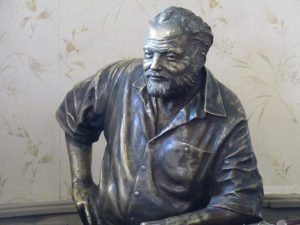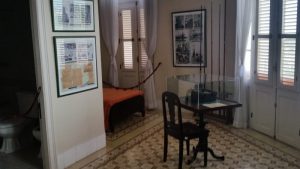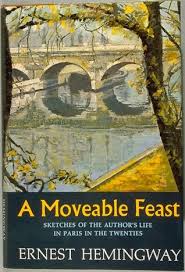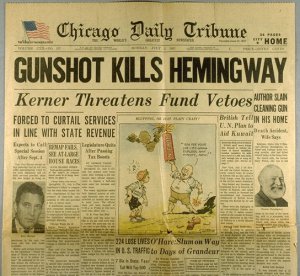In the Footsteps of… Ernest Hemingway
Marie Anne Cope travels to Cuba on a modern-day pilgrimage to the tragic, legendary author
We all have places we long to go in the world; places friends have visited; places told to us by strangers; places that are part of family tradition; places revealed to us in films; places glimpsed on TV; places made famous by a celebrity; places made infamous by a legend. It was the latter for me, dear reader.
Cuba – or, more specifically, Havana – had a firm place at the top of my bucket list thanks to the legend that was Ernest Hemingway. This year, I decided my visit was long overdue.
Cuba, a country caught almost in a time warp, thanks to Castro, of 1950s cars, dilapidated buildings and very low crime, is slowly starting to emerge into the 21st century, thanks to the relaxation of embargos. The streets and parking lots, though still teeming with brightly coloured Packards, Chevys, Buicks, Oldsmobiles, Caddys, Dodges, Pontiacs… are now marred by their more modern counterparts. Soon this tourist attraction will disappear, along with the streetside cafés, as Starbucks moves in (as it eventually will) along with other known high street brands, to tear apart and destroy forever the pastel-fronted stone facades of the buildings, housing quaint shops selling Cuban merchandise. Soon, ‘Cuban made’, as with many countries, will be a thing of the past.
For me, I HAD to see the country, experience the culture, take in the architecture, breathe in the gasoline and absorb the history before it is taken away from us forever.
My interest in Cuba came through Hemingway, my interest in Hemingway through his memoirs – A Moveable Feast – and A Moveable Feast through the film City of Angels. To walk the streets he walked, to absorb the atmosphere of his favourite watering holes and to submerge myself in the city he loved, the city he made a home, was, and will always be, a pilgrimage.

Sadly, I never got to visit the home he bought, Finca Vigia, due to its distance from the centre, but I did visit the rest. I sipped daiquiris whilst enjoying piano music in the stunning Art Deco Hotel Ambos Mundos, where Hemingway lived on arrival in Cuba in 1939. I drank mojitos whilst the locals jammed at La Bodeguita del Medio and I enjoyed the culinary delights of Havana in La Floridita, where a life-size bronze sculpture of the great author props up one end of the bar, waiting to share a drink and a conversation about literature with you.
For me, Hemingway is Havana and Havana is Hemingway!
But how much do you really know about Hemingway, the monumental talent, whose life was tinged with tragedy?
Hemingway was the second of four children and was given the middle name of ‘Miller’. He was married four times (Hadley Richardson, Pauline Pfeiffer, Martha Gellhorn and Mary Welsh) and had three sons (John Hadley Nicanor with Richardson; Patrick and Gregory Hancock with Pfeiffer). In his lifetime, Hemingway published seven novels, six short story collections and two non-fiction works. Posthumously, he published three novels, four short story collections and three non-fiction works.
He was raised in Oak Park, Illinois and, after high school, he became a reporter for the Kansas City Star. Hemingway always relied on the Star’s style guide in his writing:
‘Use short sentences. Use short first paragraphs. Use vigorous English. Be positive, not negative.’
He hadn’t been at the Star long before he enlisted in World War I and was sent to the Italian Front as an ambulance driver. On 8 July 1918, Hemingway was seriously wounded by mortar fire, receiving severe shrapnel wounds in both legs. Despite these wounds, he assisted Italian soldiers to safety and received the Italian Silver Medal of Bravery. His shrapnel wounds, however, left him with lingering pain, which led him to spend a great deal of time standing up to type at his typewriter, as this was more comfortable than sitting.
In 1919, following recuperation, Hemingway was sent home. What he said of his experience always reminds me of the way I felt before and after my parachuting accident:
‘When you go to war as a boy you have a great illusion of immortality. Other people get killed; not you… Then when you are badly wounded for the first time you lose that illusion and you know it can happen to you.’
Did you know, dear reader, that it was his great friend F Scott Fitzgerald’s awesome novel, The Great Gatsby, which inspired Hemingway to write a novel? Thank goodness it did, otherwise the literary world would have missed out – big time!
Two of his great novels have included his time during World War I. A Farewell to Arms (1929), a novel with an ending that he rewrote SEVEN times, is based on his experiences during World War I and also includes a fictionalised account of the difficult birth of his second son, Patrick. Conversely, Death in the Afternoon (1932) focuses on a single event which scarred the author. It describes his first day in Milan in 1918, when he was sent to the scene of a munitions factory explosion where they retrieved the shredded remains of female workers.
On 21 July 1925, his birthday, Hemingway sat down to write his phenomenal The Sun Also Rises, and eight weeks later he was done. A feat many writers would love to achieve; I know I would!
The end of the decade saw Hemingway struck a devastating blow as his father, plagued with financial worries as many were at this time, took his own life in 1928. As if this wasn’t sad enough, a shiver rippled down my spine when I learned of the words which Hemingway uttered in response to his father’s death:
‘I’ll probably go the same way’.
An omen if ever I heard one, don’t you agree?
The 1930s did not yield much from Hemingway, with To Have and Have Not being the only novel he penned during this decade. The latter part of the decade saw him head off to war again as he reported on the Spanish Civil War for the North American Newspaper Alliance (NANO).

It was at the end of this decade that Hemingway crossed to Cuba on his boat, the Pilar, taking up residence at the Hotel Ambos Mundos. His room, 511, is now a shrine to the great author and showcases some of his passions in life, including his typewriter and fishing rods.
Hemingway’s third wife, Martha Gellhorn, was the one who inspired him to write For Whom the Bell Tolls (1940). He began the novel in March 1939 and finished it in July 1940, writing, as was his way, in three different locations: Cuba, Wyoming and Sun Valley. The novel became a Book of the Month Club choice and sold 500,000 copies in the first few months – a feat the rest of us can only dream of!
For Whom the Bell Tolls was also nominated for a Pulitzer Prize and, according to his biographer Meyers, the novel ‘triumphantly re-established Hemingway’s literary reputation.’
Hemingway once again joined the war effort in World War II and in 1947 he received a Bronze Star for Bravery, awarded due to having been ‘under fire in combat areas in order to obtain an accurate picture of conditions’.
It was during the 1940s when Hemingway’s mojo took a major hit as he declared himself ‘out of business as a writer’. This decade saw him and his family suffer several accidents and, as he watched his literary friends start to die off, he sank into a depression which, arguably, he never truly recovered from. The accidents and his years of heavy drinking were also taking their toll on his health, as he suffered severe headaches, weight problems and, eventually, diabetes.
It was the bad reviews for Across the River and Into the Trees which could be credited with restoring Hemingway’s lust for writing and, arguably, fuelled the success of his next novel. In 1951, furious at the reviews, he wrote The Old Man and the Sea in eight weeks (seems to be his magic number!), commenting that it was:
‘The best I can write in all of my life.’
The Old Man and the Sea became a Book of the Month Club selection and made him an international celebrity. On top of that, not only was it nominated for a Pulitzer, but, in May 1952, it won!
Despite the meteoric success of The Old Man and the Sea, bad luck continued to dog Hemingway. In 1954, not long after The Old Man and the Sea was published, he went on safari to Africa and was almost killed in two successive plane crashes. The first plane crash landed after hitting an abandoned utility pole; the second exploded on take-off. The plane crashes left Hemingway in pain and ill health for the rest of his life. Prior to the plane crashes, he had been a ‘thinly controlled alcoholic for most of his life’, but afterwards he started to drink more heavily ‘to combat the pain of his injuries’.
The same year he almost died was the year Hemingway was awarded the Nobel Prize for Literature. He always carried suspicions, however, that the erroneous obituaries following his plane crashes were the only reasons he received the award. His injuries prevented him travelling to Stockholm, but he sent his speech which, for me, defines the life of a writer extremely well:
‘Writing, at its best, is a lonely life. Organisations for writers palliate the writer’s loneliness but I doubt if they improve his writing. He grows in public stature as he sheds his loneliness and often his work deteriorates. For he does his work alone and if he is a good enough writer he must face eternity, or the lack of it, each day.’
His health continued to deteriorate and he was bedridden for much of 1955/56 and told to stop drinking to try and mitigate the damage to his liver. Hemingway, of course, did not acquiesce. He travelled to Europe towards the latter end of 1955, where he became ill and was treated for high blood pressure, liver disease and arteriosclerosis.

It was while he was in Europe – in Paris, to be more precise – in November 1956 that he found trunks he had stored at the Ritz Hotel, when he had lived there in 1928. The trunks were filled with notebooks and writings from his Paris years. It was the scribblings in these notebooks that Hemingway starting forming into his memoir, A Moveable Feast, when he returned to Cuba in 1957. If he had never found those trunks, he’d never have written his memoir and I would probably never have fallen in love with him.
After the 1961 Bay of Pigs invasion, Finca Vigia, Hemingway’s Cuban home, was expropriated by the Cuban government. Within the house was his collection of somewhere between 4000 and 6000 books! Hemingway left Cuba for good on 25 July 1960. Although Finca Vigia was open to the public for many years, as a museum to Hemingway, the theft of pages from his precious collection of books meant that the house had to be kept closed. Although still a tourist attraction, Finca Vigia can only be viewed from the outside in, a poignant reminder on how we observe the lives of celebrities such as Hemingway.
The End is Nigh
In late 1960, Hemingway was plagued with worries about money, about his taxes and how he’d never return to Cuba to retrieve the manuscripts he’d locked away in a bank vault in Havana. He became exceedingly paranoid that the FBI were watching him, in his now home of Ketchum, Idaho. He wasn’t entirely wrong on this matter. The FBI HAD opened a file on him during World War II because he’d used his boat, the Pilar, to patrol the waters off Cuba. This led Hoover to have an agent watch him throughout the 1950s.
In November 1960, Hemingway was checked into the Mayo Clinic under his doctor’s name – Saviers – to protect his identity. Here he was treated with electroconvulsive therapy (electroshock therapy) as many as FIFTEEN times during December of that year. He was finally released in January 1961 ‘in ruins’. His medical records from the Mayo Clinic apparently indicate that the combination of medications he was taking may have created the depressive state for which he was treated, and which also plagued him throughout his life.
In April 1961, Mary found Hemingway holding a shotgun and called his doctor. He was sedated and taken to hospital and then transferred back to the Mayo Clinic, where he was subjected to more electroconvulsive therapy. He wasn’t released until June, returning home on 30 June 1961.

Two days later, in the early hours of 2 July 1961, Ernest Miller Hemingway shot himself with his favourite rifle. He had gone down to the basement where his guns were kept locked up and then taken his rifle up to the front entrance foyer of his home and shot himself.
Although Hemingway ‘had died of a self-inflicted wound to the head’, the story told to the press was that it was an accident. It wasn’t until five years later that Mary, during a press interview, revealed that Hemingway had in fact taken his own life.
Hemingway is buried in Ketchum cemetery, the Catholic priest officiating allowing the burial as he believed Hemingway’s death to be an accident. In 1966, a memorial to Hemingway was erected just north of Sun Valley, above Trail Creek. It is inscribed with a eulogy Hemingway had written for a friend years earlier, but which also applied to him:
‘Best of all he loved the fall,
the leaves yellow on cottonwoods,
leaves floating on trout streams,
and above the hills,
the high blue windless skies…..Now he will be part of them forever.’
During the last years of his life, Hemingway had exhibited behaviour similar to that of his father prior to his suicide. It is thought that Hemingway’s father may have suffered from the genetic condition haemochromatosis, something for which Hemingway was diagnosed early in 1961. Haemochromatosis is the inability to metabolise iron, which culminates in mental and physical deterioration. The treatment for this is fairly simple: phlebotomy or blood-letting, on a regular basis. I wonder if this was a treatment available in the 1960s, and whether Hemingway actually was treated or whether it was already too late for him. I feel it is worth noting that his sister, Ursula, and brother, Leicester, also committed suicide. Were they too afflicted with the same disorder?
Ernest Miller Hemingway – such an influential, inspirational, meteoric yet tragic life. A man who, plagued by fears of being left by women after his first love abandoned him, chose to abandon his wives first; a soul at the mercy of recurring depression; a talent who chose to drown his difficulties in alcohol. My heart aches as I think of all he achieved and all he suffered.
Hemingway will always be an inspiration to me and Havana will always be my pilgrimage to him.
‘I don’t know what a pear tastes like to you.’
(Nicholas Cage to Meg Ryan in City of Angels.)
© Marie Anne Cope 2017
